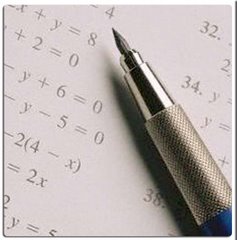DIRECTIONS for Questions 1 to 3: Answer the questions on the basis of the information given below.
Seven varsity basketball players (A, B, C, D, E, F, and G) are to be honoured at a special luncheon. The
players will be seated on the dais in a row. A and G have to leave the luncheon early and so must be seated
at the extreme right. B will receive the most valuable player's trophy and so must be in the centre to
facilitate presentation. C and D are bitter rivals and therefore must be seated as far apart as possible.
1. Which of the following cannot be seated at either end?
[1] C [2] D [3] F [4] G
2. Which of the following pairs cannot be seated together?
[1] B&D [2] C&F [3] D&G [4] E & A
3. Which of the following pairs cannot occupy the seats on either side of B?
[1] F&D [2] D&E [3] E&G [4] C & F
Saturday, June 2, 2007
Subscribe to:
Post Comments (Atom)




5 comments:
1)3
2)4
3)3
gunda is wrong..i think
BRAIN DRILL FROM GUNDASWAMI
A newsstand will display exactly one copy each of six
different magazines— M, O, P, S, T, and V— in a single
row on a rack. Each magazine will occupy exactly one of
the six positions, numbered consecutively 1 through 6.
The magazines must be displayed in accordance with the
following rules:
Either P or else T occupies position 1.
Either S or else T occupies position 6.
M and O, not necessarily in that order, occupy consecutively
numbered positions.
V and T, not necessarily in that order, occupy consecutively
numbered positions.
1.Which of the following is an order in which the six
magazines can be arranged, from position 1 through
position 6?
(A) M, O, P, S, V, T
(B) P, O, S, M, V, T
(C) P, V, T, O, M, S
(D) P, V, T, S, O, M
(E) T, P, V, M, O, S
2.If P occupies position 3, which of the following must
be true?
(A) M occupies position 4.
(B) O occupies position 2.
(C) S occupies position 5.
(D) T occupies position 6.
(E) V occupies position 2.
3.If O and T, not necessarily in that order, occupy
consecutively numbered positions, then T can be in
position
(A) 1
(B) 2
(C) 4
(D) 5
(E) 6
1. [3]
2. [1][3]
3. dont understand
its
1)4 as g cannot b on the other end
2)4
3)3
3 4 3
Post a Comment